Cultural Ecosystem Services in Rural Areas: Assessing Demand and Supply for Ecologically Functional Areas (EFA)
Abstract
1. Introduction
2. Materials and Methods
2.1. Study Area
2.2. Spatial Data
- Agricultural land—arable land, meadows, pastures, allotment gardens, and fallow land
- Forested land—coniferous, deciduous, and mixed forests
- Wetlands—bogs, peatlands, and marshes
- Aquatic land—rivers, lakes, ponds, and other inland water bodies
- the graphic annex to the “Amendment to the Study of Conditions and Directions of Spatial Development of Sosnowica Municipality” [30]
- soil and agricultural maps (Institute of Soil Science and Plant Cultivation—2021) [31]
- cadastral data from the District Office in Parczew [32]
- the Topographic Objects Database (BDOT10k) [33]
- the authors’ own field inventory
2.3. Indicator-Based Analyses
2.3.1. CES Supply Assessment
2.3.2. CES Demand Assessment
2.3.3. Supply–Demand Balance
- balanced supply and demand,
- untapped potential,
- need for planning and infrastructure interventions.
2.4. Survey (Demand/Perception)
Sampling and Implementation
- EFA identification and visit frequency within the previous 12 months.
- Tourism attractiveness (survey-based TAI): up to three most frequently visited EFAs rated across environmental, cultural, and hospitality/service dimensions on a 1–5 Likert scale.
- Transport accessibility (survey-based TRAI): assessment of access, parking, and distance/time barriers on a 1–5 Likert scale.
- Visitor intensity and crowding: perceived crowding and its effect on comfort.
- Use and expenditures (demand): recreational, educational, and spiritual activities in the last three years and willingness to pay (WTP) monthly contributions to maintain EFA values [4].
2.5. Statistical Analyses
3. Research Results
3.1. CES Demand—Biophysical Values
3.2. Assessment of Supply and Demand
3.3. Balance of CES Supply and Demand Across EFAs
3.4. Variation in the CES Supply—Demand Balance at the Local Level of the Municipality of Sosnowica
4. Discussion
5. Conclusions
- The relationships between the supply and demand of cultural ecosystem services (CES) differ significantly depending on the type of ecologically functional area (EFA). The applied method of integrating biophysical and socio-economic indicators not only confirmed these differences statistically (Kruskal–Wallis test) but also linked them to user perception.
- Forests and agricultural land are characterized by a high supply of CES, although in the case of agricultural land this potential remains largely underutilized due to low social interest. Wetlands, in turn, exhibit a relative service deficit, which limits their tourism and recreational functions, despite their significant ecological and educational potential.
- Agricultural land shows the largest surplus of supply over demand. Although its potential is not currently recognized by the community, it may support the development of agritourism, educational offerings, and cultural trails. However, addressing infrastructural issues (e.g., parking availability) will be essential.
- Wetlands, despite being rated as having low tourism attractiveness by respondents, play important ecological roles and hold potential for niche forms of tourism (e.g., birdwatching, educational tourism). Local authorities should focus on protecting these areas while simultaneously promoting their unique values.
- Most of the analyzed EFAs demonstrate a surplus of CES supply over demand, which indicates a general but underutilized potential for the development of tourism, recreation, and environmental education in the Sosnowica commune. However, the mere existence of a supply surplus does not guarantee community interest—spatial policies must be tailored to the specific characteristics of each EFA type.
- The innovative contribution of this study lies in the integration of biophysical and social analyses within a single methodological framework. This approach enables not only the quantitative assessment of CES supply and demand but also the identification of discrepancies between environmental potential and social perception. In doing so, it provides a practical tool for planners and policymakers—highlighting where to invest in infrastructure, where to undertake promotional activities, and where to prioritize resource protection.
Supplementary Materials
Author Contributions
Funding
Institutional Review Board Statement
Informed Consent Statement
Data Availability Statement
Conflicts of Interest
References
- Tribot, A.-S.; Deter, J.; Mouquet, N. Integrating the Aesthetic Value of Landscapes and Biological Diversity. Proc. R. Soc. B 2018, 285, 20180971. [Google Scholar]
- Millennium Ecosystem Assessment, Ecosystems and Human Well-Being: Synthesis; Island Press: Washington, DC, USA, 2005.
- Lausi, L.; Amodio, M.; Sebastiani, A.; Fusaro, L.; Manes, F. Assessing Cultural Ecosystem Services During the COVID-19 Pandemic at the Garden of Ninfa (Italy). Ann. Bot. 2022, 12, 63–75. [Google Scholar]
- Wyłupek, T.; Lipińska, H.; Kępkowicz, A.; Adamczyk-Mucha, K.M.; Lipiński, W.; Franczak, S.; Duniewicz, A. Cultural ecosystem services of grassland communities: A case study of lubelskie province. Sustainability 2025, 17, 6697. [Google Scholar] [CrossRef]
- Mikkonen, J.; Raatikainen, K.J. Aesthetics in Biodiversity Conservation. Art Crit. 2024, 82, 174–190. [Google Scholar]
- Hermes, J.; Van Berkel, D.; Burkhard, B.; Plieninger, T.; Fagerholm, N.; von Haaren, C. Assessment and valuation of recreational ecosystem services of landscapes. Ecosyst. Serv. 2018, 31, 289–295. [Google Scholar] [CrossRef]
- Notte, A.L.; Marongiu, S.; Masiero, M.; Molfetta, P.; Molignoni, R.; Cesaro, L. Livestock and Ecosystem Services: An Exploratory Approach to Assess Agri-Environment-Climate Payments of RDP in Trentino. Land 2015, 4, 688–710. [Google Scholar] [CrossRef]
- Huntsinger, L.; Oviedo, J.L. Ecosystem services are social–ecological services in a traditional pastoral system: The case of California’s Mediterranean rangelands. Ecol. Soc. 2014, 19, 8. [Google Scholar] [CrossRef]
- Vihervaara, P.; Viinikka, A.; Brander, L.; Santos-Martín, F.; Poikolainen, L.; Nedkov, S. Methodological Interlinkages for Mapping Ecosystem Services—From Data to Analysis and Decision-Support. One Ecosyst. 2019, 4, e26368. [Google Scholar] [CrossRef]
- Legesse, F.; Degefa Geleto, S.; Soromessa, T. Valuation Methods in Ecosystem Services: A Meta-analysis. World J. For. Res. 2022, 1, 1–12. [Google Scholar] [CrossRef]
- Pe’er, G.; Zinngrebe, Y.; Hauck, J.; Schindler, S.; Dittrich, A.; Essl, F. Adding some green to the greening: Improving the EU’s Ecological Focus Areas for biodiversity and farmers. Conserv. Lett. 2014, 10, 517–530. [Google Scholar] [CrossRef]
- Ottoy, S.; Angileri, V.; Gibert, C.; Paracchini, M.L.; Pointereau, P.; Terres, J.-M.; Van Orshoven, J.; Vranken, L.; Dicks, L.V. Impacts of selected Ecological Focus Area options in European farmed landscapes on climate regulation and pollination services: A systematic map protocol. Environ. Evid. 2018, 7, 10. [Google Scholar] [CrossRef]
- Newsham, N.; Rowe, F. Understanding Trajectories of Population Decline Across Rural and Urban Europe: A Sequence Analysis. Popul. Space Place 2022, 28, e2630. [Google Scholar] [CrossRef]
- Bański, J. Współczesne problemy i wyzwania rozwoju obszarów wiejskich w Polsce. Stud. Obsz. Wiej. 2023, 60, 15–31. [Google Scholar]
- Wu, S.; Liu, K.-D.; Zhang, W.; Dou, Y.; Chen, Y.; Li, D. To better understand realized ecosystem services: An integrated analysis framework of supply, demand, flow and use. arXiv 2023, arXiv:2309.15574. [Google Scholar] [CrossRef]
- Zhang, W.; Luo, Y.; Yi, T.; Wang, N.; Wu, J. Mapping and Assessing the Supply and Demand of Rural Cultural Ecosystem Services in Changhong Township, China. Land 2024, 14, 302. [Google Scholar] [CrossRef]
- Bennett, E.M.; Peterson, G.D.; Gordon, L.J. Ecosystem services supply and demand assessment: Why social–ecological dynamics matter. One Ecosyst. 2017, 2, e13276. [Google Scholar]
- Paracchini, M.L.; Zulian, G.; Kopperoinen, L.; Maes, J.; Schägner, J.P.; Termansen, M.; Bidoglio, G. Mapping cultural ecosystem services: A framework to assess the potential for outdoor recreation across the EU. Ecol. Indic. 2014, 45, 371–385. [Google Scholar] [CrossRef]
- Vrbičanová, G.; Kaisová, D.; Močko, M.; Petrovič, F.; Mederly, P. Mapping Cultural Ecosystem Services Enables Better Informed Nature Protection and Landscape Management. Sustainability 2020, 12, 2138. [Google Scholar] [CrossRef]
- Turčinović, M.; Vujko, A.; Stanišić, N. Community-Led Sustainable Tourism in Rural Areas: Enhancing Wine Tourism Destination Competitiveness and Local Empowerment. Sustainability 2025, 17, 2878. [Google Scholar] [CrossRef]
- Available online: https://www.bdl.lasy.gov.pl/portal (accessed on 17 May 2022).
- Available online: https://stat.gov.pl/statystyki-eksperymentalne/uslugi-publiczne/analiza-walorow-turystycznych-powiatow-i-ich-bezposredniego-otoczenia,1,1.html (accessed on 7 December 2022).
- Available online: https://nowa.sosnowica.pl/gmina/walory-gminy (accessed on 4 December 2022).
- Available online: https://polesie-sosnowica.pl/ (accessed on 8 October 2020).
- Strategia Rozwoju Gminy Sosnowica na Lata 2015–2020. 2015. Available online: https://nowa.sosnowica.pl/wp-content/uploads/2020/06/006_Aktualizacja_strategii_rozwoju_gminy_SOSNOWICA_2015_2020.pdf (accessed on 2 June 2021).
- Available online: https://lublin.stat.gov.pl/opracowania-biezace/opracowania-sygnalne/ludnosc/stan-i-ruch-naturalny-ludnosci-w-wojewodztwie-lubelskim-w-2024-r-,1,29.html (accessed on 15 June 2025).
- Available online: https://crfop.gdos.gov.pl/CRFOP/ (accessed on 18 March 2022).
- Available online: https://geoportal.gov.pl (accessed on 25 February 2021).
- Available online: https://www.eea.europa.eu/data-and-maps/data/eunis-habitat-classification (accessed on 6 November 2020).
- Modification of the Spatial Development Plan Study for the Municipality of Sosnowica original: Zmiana studium uwarunkowań i kierunków zagospodarowania przestrzennego gminy Sosnowica. Kierunki, 2011. Available online: https://mpzp.igeomap.pl/doc/parczew/sosnowica/000.pdf (accessed on 15 January 2021).
- Available online: https://geoserwis.gdos.gov.pl/mapy/ (accessed on 11 September 2020).
- Available online: https://bdl.stat.gov.pl/bdl/start (accessed on 10 May 2021).
- Available online: https://www.geoportal.gov.pl/dane/baza-danych-obiektow-topograficznych-bdot (accessed on 16 January 2020).
- Available online: https://stat.gov.pl/files/gfx/portalinformacyjny/pl/defaultaktualnosci/5494/1/13/1/turystyka_w_2015.pdf?fbclid=IwY2xjawM4vcJleHRuA2FlbQIxMABicmlkETA2TklLUXJuUHg2blppaDFPAR64yklnwgVRaPGXH7mHDTwntRtepbD-b3ewEoEgevtmNyqTg4Bz1Lkgyx5p-Q_aem_7zXSJHhWtySkfGfunBbpWA (accessed on 25 February 2021).
- Szromek, A.R. Pomiar funkcji turystycznej obszarów za pomocą wskaźników funkcji turystycznej na przykładzie obszarów państw europejskich. Studia Ekonomiczne. Zastos. Metod. Mat. W Ekon. I Zarządzaniu 2013, 132, 91–103. [Google Scholar]
- Kamiński, P. Valuation of Recreational Ecosystem Services: Examples and Application Issues. Stud. I Pr. WNEiZ 2022, 69, 34–47. [Google Scholar]
- Tindale, S.; Vicario-Modro, V.; Gallardo-Cobos, R.; Hunter, E.; Miskolci, S.; Newell Price, P.; Sánchez-Zamora, P.; Sonnevelt, M.; Ojo, M.; McInnes, K.; et al. Citizen Perceptions and Values Associated with Ecosystem Services from European Grassland Landscapes. Land Use Policy 2023, 127, 106574. [Google Scholar] [CrossRef]
- Arnaiz-Schmitz, C.; Herrero-Jáuregui, C.; Gutiérrez-Angonese, J.; Schmitz, M.F. Cultural ecosystem services and social-ecological resilience in rural landscapes: A case study in Mediterranean dehesas. Landsc. Urban Plan. 2021, 214, 104164. [Google Scholar] [CrossRef]
- Zhao, S.; Li, Y.; Nie, Z.; Li, Y. Supply–Demand Assessment of Cultural Ecosystem Services in Urban Parks of Plateau River Valley City: A Case Study of Lhasa. Land 2025, 14, 1301. [Google Scholar] [CrossRef]
- Zhang, J.; He, C.; Huang, Q.; Li, J.; Qi, T. Evaluating the supply and demand of cultural ecosystem services in the Tibetan Plateau of China. Landsc. Ecol. 2022, 37, 2131–2148. [Google Scholar] [CrossRef]
- Yang, Y.; Jiang, L.; Ma, X.; Liu, S.; Wang, L. A Comprehensive Approach to Identifying the Supply and Demand of Urban Park Cultural Ecosystem Services in the Megalopolis Area of Shanghai, China. Land 2025, 14, 455. [Google Scholar] [CrossRef]
- Liu, Y.-L.; Chiang, J.-T.; Ko, P.-F. The Benefits of Tourism for Rural Community Development. Humanit. Soc. Sci. Commun. 2023, 10, 137. [Google Scholar] [CrossRef] [PubMed]
- Haines-Young, R.; Potschin, M. Common International Classification of Ecosystem Services (CICES) V5.1—Guidance on the Application of the Revised Structure; European Environment Agency: Copenhagen, Denmark, 2018; Available online: https://cices.eu/resources/ (accessed on 10 June 2021).
- Solon, J.; Zielińska, E.; Affek, A.; Kowalska, A.; Grabińska, B.; Kruczkowska, B.; Wolski, J.; Degórski, M.; Kołaczkowska, E.; Regulska, E.; et al. Świadczenia Ekosystemowe w Krajobrazie Młodoglacjalnym. Ocena Potencjału i Wykorzystania; Instytut Geografii i Przestrzennego Zagospodarowania PAN, Wydawnictwo Akademickie SEDNO: Warszawa, Poland, 2017; ISBN 9788379630622. [Google Scholar]
- Fornal-Pieniak, B.E.; Żarska, B. Evaluation of Landscape Natural Values in Tourism, with Special Emphasis on Vegetation. Pol. J. Environ. Stud. 2021, 30, 663–674. [Google Scholar] [CrossRef]
- Kreye, M.M.; Adams, D.C.; Ghimire, R.; Morse, W.; Bowker, J.M. Forest Ecosystem Services: Cultural Values. In General Technical Report SRS-226; U.S. Department of Agriculture Forest Service, Southern Research Station: Asheville, NC, USA, 2017; pp. 1–20. [Google Scholar]
- Plieninger, T.; Dijks, S.; Oteros-Rozas, E.; Bieling, C. Assessing, mapping, and quantifying cultural ecosystem services at community level. Land Use Policy 2013, 33, 118–129. [Google Scholar] [CrossRef]
- Schirpke, U.; Scolozzi, R.; Dean, G.; Haller, A.; Jäger, H.; Kister, J.; Kovács, B.; Sarmiento, F.O.; Sattler, B.; Schleyer, C. Cultural ecosystem services in mountain regions: Conceptualising conflicts among users and limitations of use. Ecosyst. Serv. 2020, 46, 101210. [Google Scholar] [CrossRef]
- Chen, W.; Zeng, Y.; Zeng, J. Impacts of traffic accessibility on ecosystem services: An integrated spatial approach. J. Geogr. Sci. 2021, 31, 1816–1836. [Google Scholar] [CrossRef]
- Zhang, Y.; Fu, B.; Sun, J.; da Silva, R.F.B. Quantifying supply and demand of cultural ecosystem services from a dynamic perspective. Land Use Policy 2025, 148, 107414. [Google Scholar] [CrossRef]
- Leban, V.; Zadnik Stirn, L.; Pezdevšek Malovrh, Š. Investigating potential supply of ecosystem services in cultural landscapes through efficiency analysis. Environ. Manag. 2024, 74, 161–179. [Google Scholar] [CrossRef]
- Torralba, M.; Lovrić, M.; Roux, J.-L.; Budniok, M.-A.; Mulier, A.-S.; Winkel, G.; Plieninger, T. Examining the relevance of cultural ecosystem services in forest management in Europe. Ecol. Soc. 2020, 25, 2. [Google Scholar] [CrossRef]
- Janeczko, E.; Woźnicka, M.; Kargul Plewa, D. Leśne ścieżki edukacyjne a problematyka gospodarowania wodą w lasach. Stud. I Mater. CEPL W Rogowie 2016, 18, 162–169. [Google Scholar]
- Soroka, A.; Mazurek-Kusiak, A.; Wojciechowska-Solis, J.; Hawlena, J. Importance of forest resources in health tourism—Wigierski National Park case study. Sylwan 2016, 160, 64–70. [Google Scholar]
- Janeczko, E.; Woźnicka, M.; Woźnicki, S. Funkcje zdrowotne lasów i ich wykorzystanie w rekreacji i turystyce. Sylwan 2018, 162, 524–534. [Google Scholar]
- Pellaton, R.; Lellei Kovács, E.; Báldi, A. Cultural ecosystem services in European grasslands: A systematic review of threats. Ambio 2022, 51, 2462–2477. [Google Scholar] [CrossRef]
- Milcu, A.I.; Hanspach, J.; Abson, D.; Fischer, J. Cultural ecosystem services: A literature review and prospects for future research. Ecol. Soc. 2013, 18, 44. [Google Scholar] [CrossRef]
- Balázsi, Á.; Dänhardt, J.; Collins, S.; Schweiger, O.; Settele, J.; Hartel, T. Understanding cultural ecosystem services related to farmlands: Expert survey in Europe. Land Use Policy 2021, 100, 104900. [Google Scholar] [CrossRef]
- Gonda, T. The importance of infrastructure in the development of accessible tourism. Journal of Infrastructure. Policy Dev. 2024, 8, 2735. [Google Scholar]
- Kowalska, A.; Włodarczyk, B. Ekosystemowe usługi kulturowe w planowaniu przestrzennym. Turyzm/Tourism 2020, 30, 23–30. [Google Scholar]
- Kujawska, M.; Łuczaj, Ł.; Typek, J. Cultural ecosystem services of rural landscapes: A case study from Poland. Sustainability 2020, 12, 4036. [Google Scholar]
- Czajkowski, M.; Budziński, W.; Campbell, D.; Giergiczny, M.; Hanley, N. Spatial Heterogeneity of Willingness to Pay for Forest Management. Environ. Resour. Econ. 2017, 68, 705–727. [Google Scholar] [CrossRef]
- Ghermandi, A.; van den Bergh, J.C.J.M.; Brander, L.M.; de Groot, H.L.F.; Nunes, P.A.L.D. Values of natural and human-made wetlands: A meta-analysis. Water Resour. Res. 2010, 46, W12516. [Google Scholar] [CrossRef]
- Sucholas, J.; Molnár, Z.; Łuczaj, Ł.; Poschlod, P. Local traditional ecological knowledge about hay management practices in wetlands of the Biebrza Valley, Poland. J. Ethnobiol. Ethnomed. 2022, 18, 9. [Google Scholar] [CrossRef]
- Kiryluk, H.; Borkowska Niszczota, M. Evaluating attractiveness of Biebrza National Park tourist values as a result of questionnaire research. Ekon. I Zarządzanie 2009, 1, 63–87. [Google Scholar]
- Abualhagag, A.; Valánszki, I. Overview Analysis of Cultural Ecosystem Services: Mapping Indicators and Categories Classification. Pol. J. Nat. Sci. 2021, 36, 333–358. [Google Scholar]
- Assandri, G.; Bogliani, G.; Pedrini, P.; Brambilla, M. Beautiful agricultural landscapes promote cultural ecosystem services and biodiversity conservation. Agric. Ecosyst. Environ. 2018, 326, 200–210. [Google Scholar] [CrossRef]
- Wang, X.; Wu, Y.; Manevski, K.; Fu, M.; Yin, X.; Chen, F. A Framework for the Heterogeneity and Ecosystem Services of Farmland Landscapes: An Integrative Review. Sustainability 2021, 22, 12463. [Google Scholar] [CrossRef]
- Chan, K.M.A.; Guerry, A.D.; Balvanera, P.; Klain, S.; Satterfield, T.; Basurto, X.; Bostrom, A.; Chuenpagdee, R.; Gould, R.; Halpern, B.S.; et al. Where are ‘Cultural’ and ‘Social’ in Ecosystem Services? BioScience 2012, 62, 744–756. [Google Scholar] [CrossRef]
- Daniel, T.C.; Muhar, A.; Arnberger, A.; Aznar, O.; Boyd, J.W.; Chan, K.M.A.; Dunk, A. Contributions of cultural services to the ecosystem services agenda. Proc. Natl. Acad. Sci. USA 2012, 109, 8812–8819. [Google Scholar] [CrossRef] [PubMed]
- Schröter, M.; van der Zanden, E.H.; van Oudenhoven, A.P.E.; Remme, R.P.; Serna-Chavez, H.M.; de Groot, R.S.; Opdam, P. Ecosystem services as a contested concept: A synthesis of critique and counter-arguments. Conserv. Lett. 2014, 7, 514–523. [Google Scholar] [CrossRef]
- Tengberg, A.; Fredholm, S.; Eliasson, I.; Knez, I.; Saltzman, K.; Wetterberg, O. Cultural ecosystem services provided by landscapes: Assessment of heritage values and identity. Ecosyst. Serv. 2012, 2, 14–26. [Google Scholar] [CrossRef]
- Burkhard, B.; Kroll, F.; Nedkov, S.; Müller, F. Mapping ecosystem service supply, demand and budgets. Ecol. Indic. 2012, 21, 17–29. [Google Scholar] [CrossRef]
- Geijzendorffer, I.R.; Martín-López, B.; Roche, P.K. Improving the identification of mismatches in ecosystem services assessments. Ecol. Indic. 2015, 52, 320–331. [Google Scholar] [CrossRef]
- Baró, F.; Gómez-Baggethun, E.; Haase, D. Mapping ecosystem service capacity, flow and demand for landscape and urban planning: A case study in the Barcelona metropolitan region. Land Use Policy 2016, 57, 405–417. [Google Scholar] [CrossRef]
- Wood, K.A.; Jupe, L.L.; Aguiar, F.C.; Collins, A.M.; Davidson, S.J.; Freeman, W.; Kirkpatrick, L.; Lobato-de Magalhães, T.; McKinley, E.; Nuno, A. A global systematic review of the cultural ecosystem services provided by wetlands. Ecosyst. Serv. 2024, 70, 101673. [Google Scholar] [CrossRef]
- Balzan, M.V.; Caruana, J.; Zammit, A. Assessing the capacity and flow of ecosystem services in multifunctional landscapes: Evidence of a rural-urban gradient in a Mediterranean small island state. arXiv 2017, arXiv:1712.02851. [Google Scholar] [CrossRef]
- Turkelboom, F.; Leone, M.; Jacobs, S.; Kelemen, E.; GarcíaLlorente, M.; Baró, F.; Barton, D.N. When we cannot have it all: Ecosystem services tradeoffs in the context of spatial planning. Ecosyst. Serv. 2018, 29, 566–57851. [Google Scholar] [CrossRef]
- Beichler, S.A.; Hasibovic, S.; Davidse, B.J.T.; Deppisch, S.; Koo, H.G. Integrative analysis of ecosystem services in human-environment systems: Integrating stakeholder perspectives and scientific modelling. J. Environ. Manag. 2015, 161, 409–423. [Google Scholar]
- Valánszki, I.; Kristensen, L.S.; Jombach, S.; Ladányi, M.; Filepné Kovács, K.; Fekete, A. Assessing Relations between Cultural Ecosystem Services, Physical Landscape Features and Accessibility in Central-Eastern Europe: A PPGIS Empirical Study from Hungary. Sustainability 2022, 14, 754. [Google Scholar] [CrossRef]
- Li, C.; Pan, Y.; Yin, W.; Lan, S. Spatial distribution and influencing factors of rural cultural ecosystem services: A case study of Fujian, China. Sci. Rep. 2025, 15, 10510. [Google Scholar] [CrossRef] [PubMed]
- Fu, B.; Xu, P.; Wang, Y.; Guo, Y.; Zhang, Y.; Li, S. Critical areas linking the supply and demand of cultural ecosystem services: Accessibility and geological disasters. Glob. Ecol. Conserv. 2020, 21, e00839. [Google Scholar] [CrossRef]
- Cheng, X.; Van Damme, S.; Li, L.; Uyttenhove, P. Cultural ecosystem services in an urban park: Understanding bundles, tradeoffs, and synergies. Landsc. Ecol. 2022, 37, 1693–1705. [Google Scholar] [CrossRef]
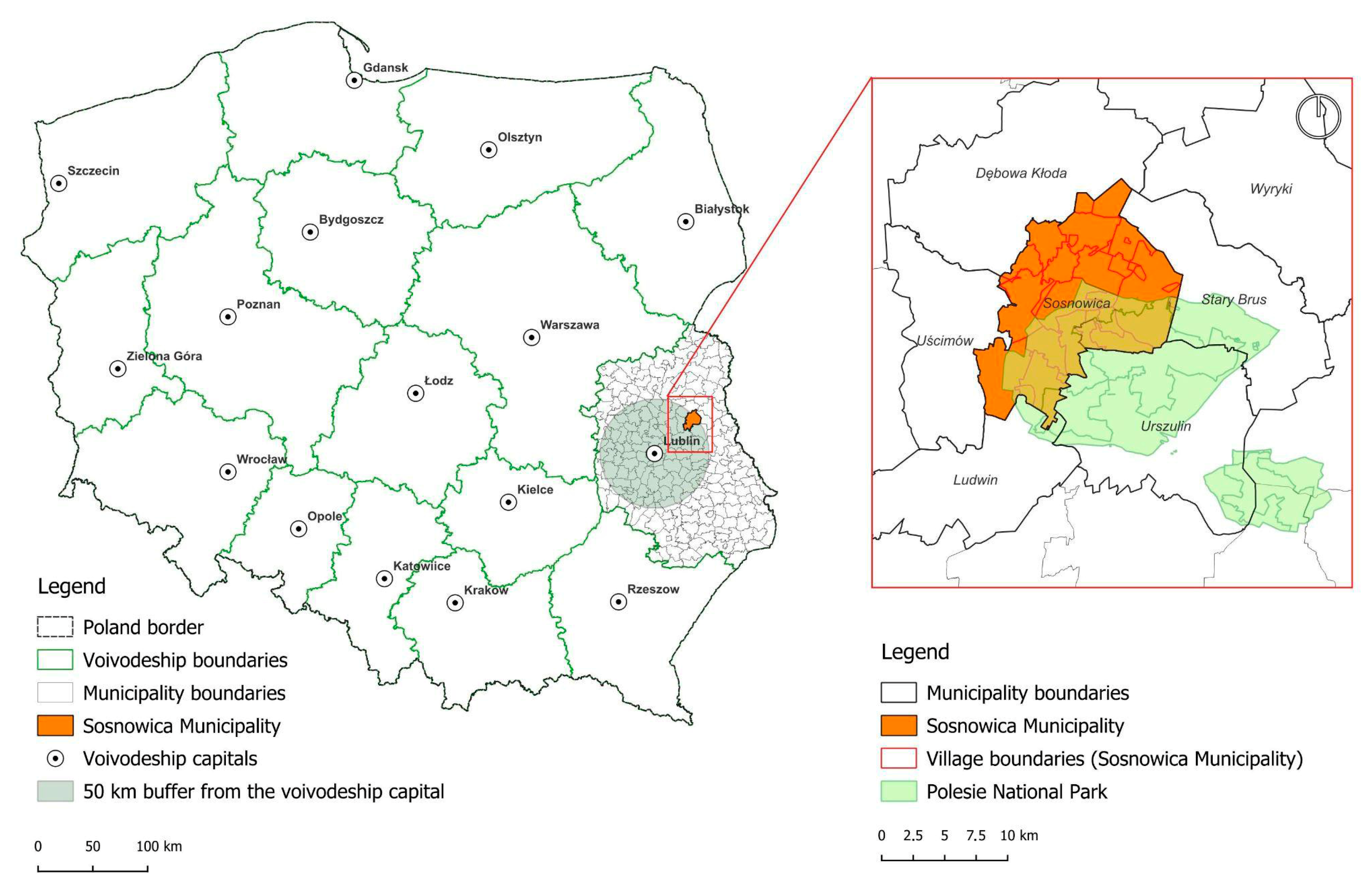
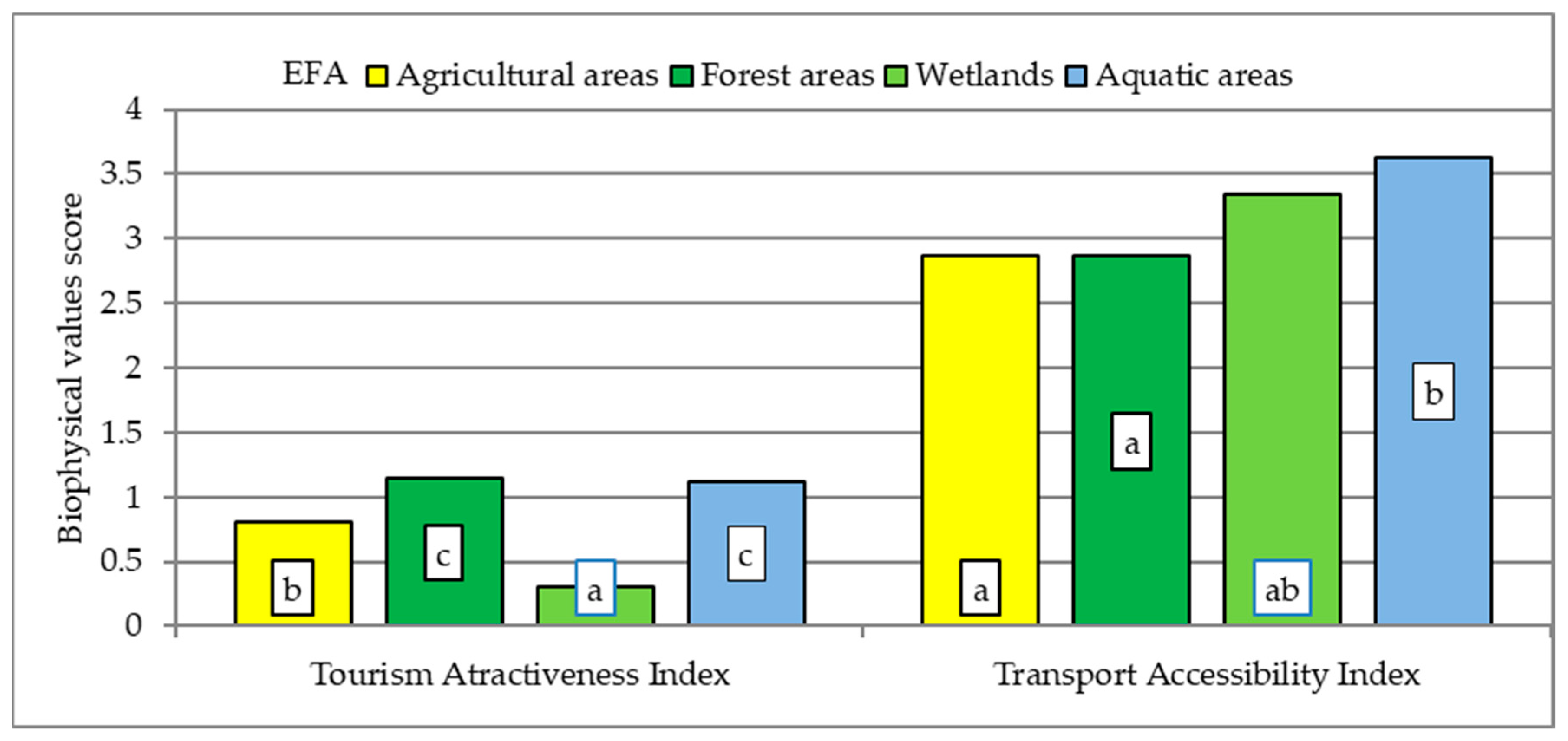
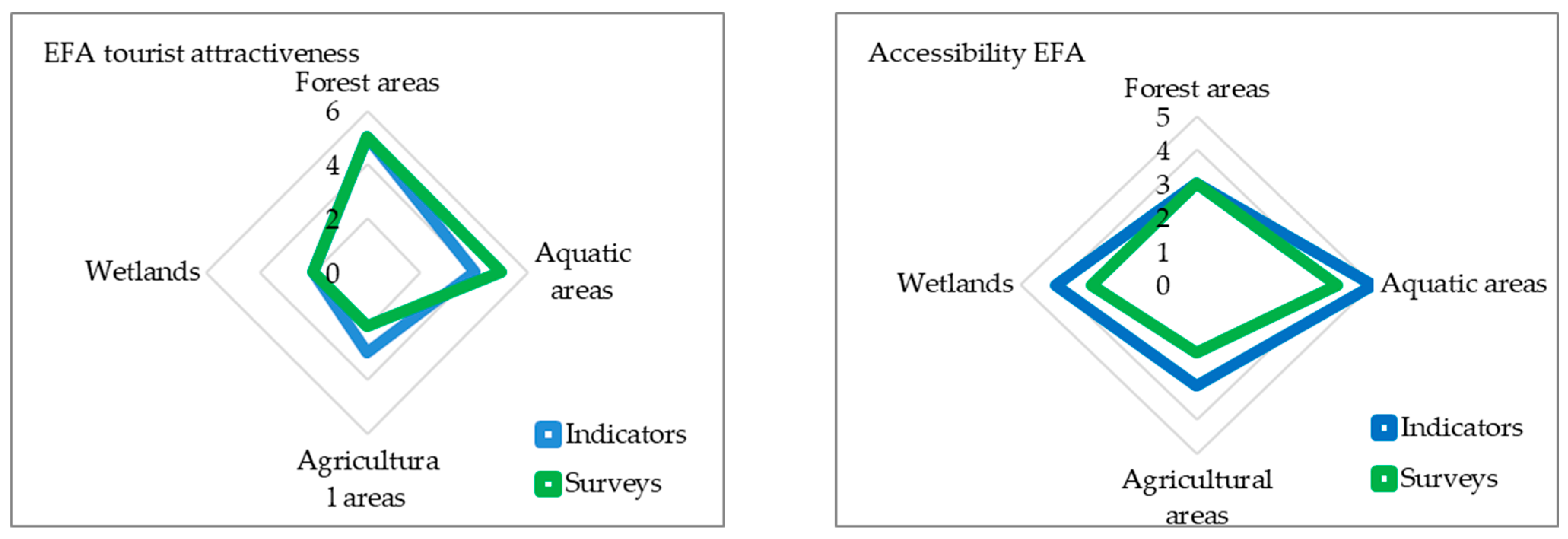
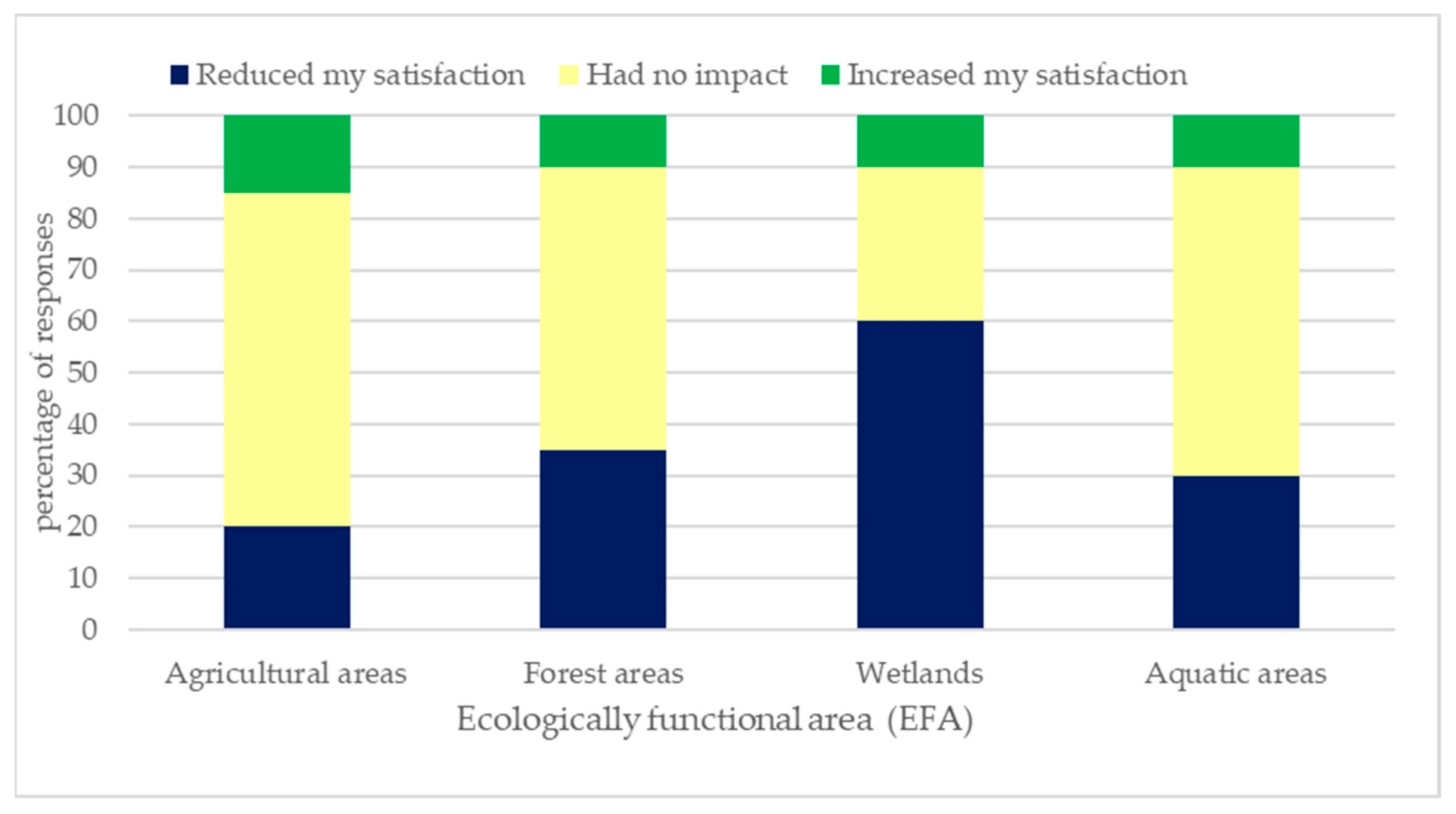
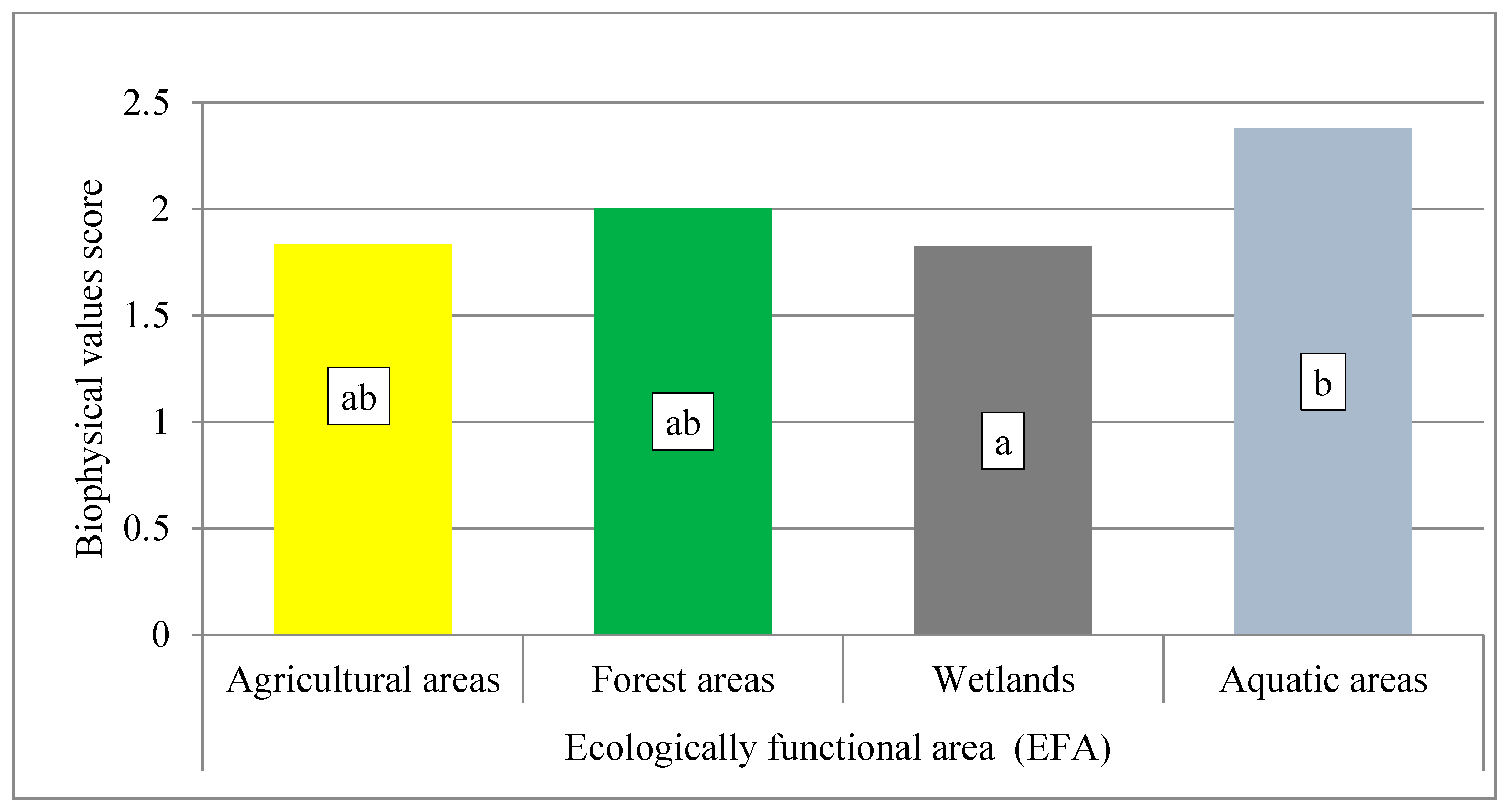
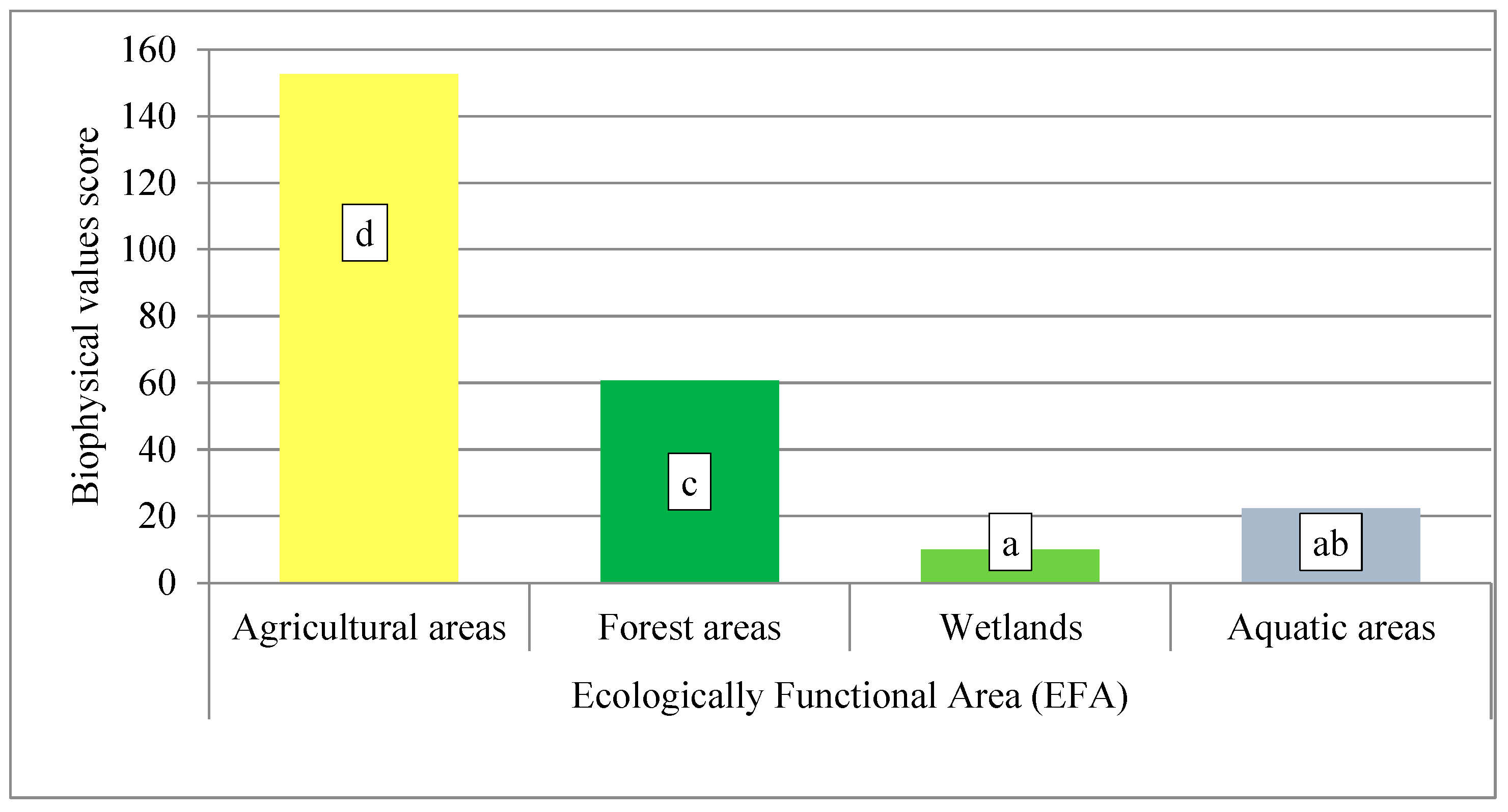

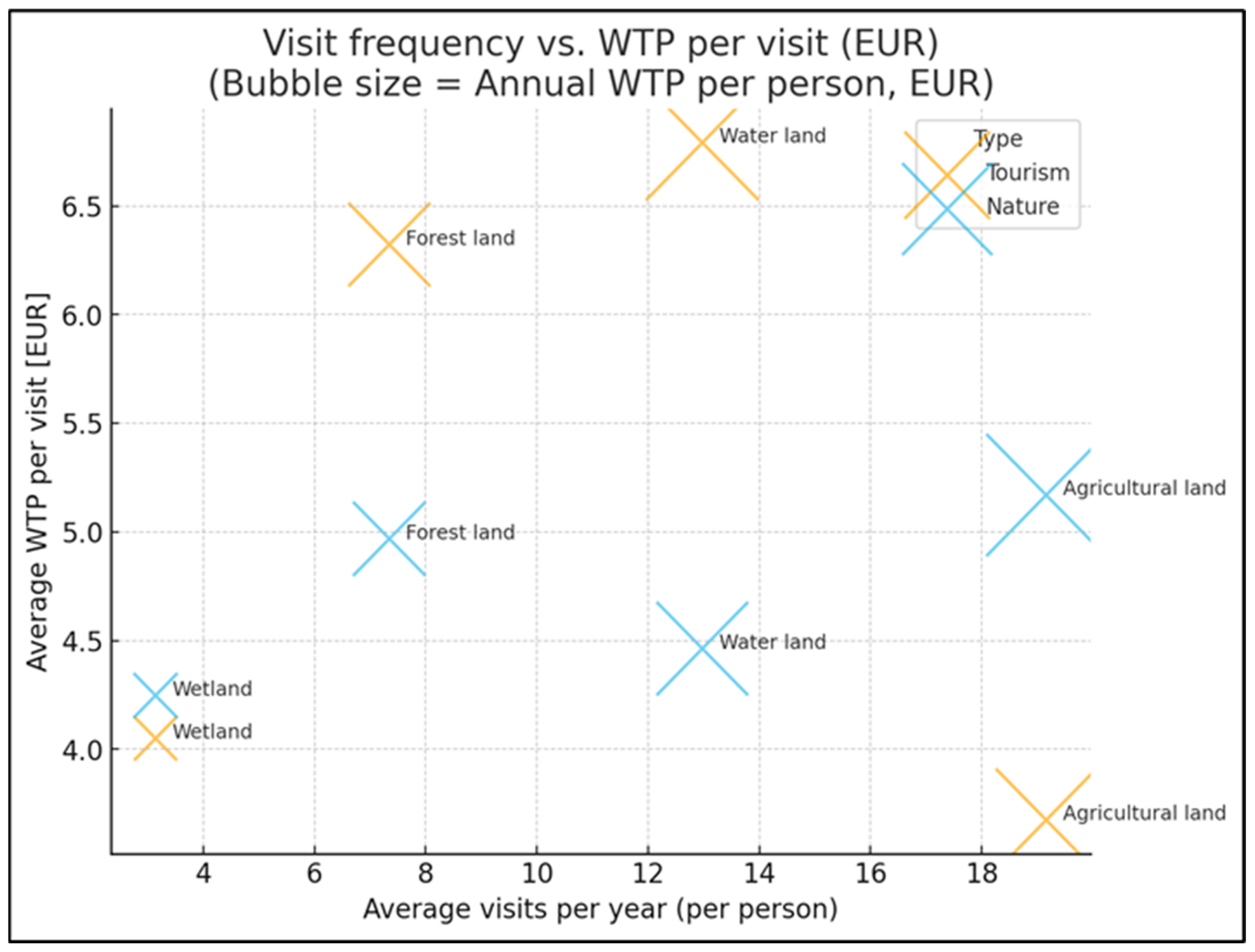



| Index | Components of the Index | Point Rating |
|---|---|---|
| Tourism Attractiveness Index (TAI) | Environmental Attractiveness Index (EAI) e.g., shoreline length, surface of waters/protected areas/Natura 2000 | 0–5 |
| Cultural Attractiveness Index (CAI) e.g., number of tourists, heritage assets (incl. UNESCO/Historic Monuments), event participants | ||
| Business and Hospitality Attractiveness Index (BHAI) e.g., accommodation capacity, conference rooms | ||
| Procedure: aggregate components → normalize to 0–5 → synthesize into TAI (higher value = higher attractiveness). | ||
| Transport Accessibility Index (TRAI) | Access to Ecologically Functional Areas (EFA) via paved roads [km] (I1) | 1–5 |
| Road distance from the village center to the EFA [km] (I2) | ||
| Distance from the EFA to the nearest parking lot or designated stopping point [km] (I3) | ||
| Procedure: Distance classes: 0–1; 1.1–2; … >5 km; the farther, the lower the score | ||
| Index | Components of the Index | Point Rating |
|---|---|---|
| Tourist Traffic Utilization Index (TTU) | Number of tourists using overnight accommodations | 1–5 with thresholds from the data distribution (Jenks natural breaks) |
| Area of ecologically functional land [km2] | ||
| Landscape Ecosystem Variability Index (LEVD) | Area of land-use change in 1990–2021 | 1–5 greater change/loss of natural values → lower score |
| Infrastructure Traffic Utilization Index (ITUI) | Counts of pedestrians, cyclists, and vehicles near EFAs (field surveys in July–August 2021) | 1–5 increase with traffic intensity |
| EFA | TAI Component | TRAI Component | ||||
|---|---|---|---|---|---|---|
| CAI | EAI | BHAI | I1 | I2 | I3 | |
| Agricultural areas | 0.83 | 0.98 | 0.59 | 0.98 | 0.95 | 0.96 |
| Forested areas | 0.79 | 0.93 | 0.66 | 0.8 | 0.73 | 0.7 |
| Wetlands | 0.97 | 0.99 | 0.19 | 0.47 | 0.49 | 0.38 |
| Aquatic areas | 0.8 | 0.93 | 0.49 | 0.8 | 0.63 | 0.69 |
| EFA | Agricultural Areas | Forested Areas | Wetlands | Aquatic Areas | ||||
|---|---|---|---|---|---|---|---|---|
| Indices | TAI | TRAI | TAI | TRAI | TAI | TRAI | TAI | TRAI |
| CES Supply | 0.73 | 0.78 | 0.72 | 0.48 | 0.91 | 0.96 | −0.25 | 0.96 |
| CES Sub-Indices | EFA | |||
|---|---|---|---|---|
| Agricultural Areas | Forested Areas | Wetlands | Aquatic Areas | |
| TTU | 0.41 | 0.93 | 0.80 | 0.99 |
| LEVD | 0.99 | 0.97 | 0.78 | 0.99 |
| ITUI | 0.63 | 0.98 | 0.84 | 0.99 |
Disclaimer/Publisher’s Note: The statements, opinions and data contained in all publications are solely those of the individual author(s) and contributor(s) and not of MDPI and/or the editor(s). MDPI and/or the editor(s) disclaim responsibility for any injury to people or property resulting from any ideas, methods, instructions or products referred to in the content. |
© 2025 by the authors. Licensee MDPI, Basel, Switzerland. This article is an open access article distributed under the terms and conditions of the Creative Commons Attribution (CC BY) license (https://creativecommons.org/licenses/by/4.0/).
Share and Cite
Michalik-Śnieżek, M.; Lipińska, H.; Woźniak-Kostecka, I.; Komor, A.; Kępkowicz, A.; Adamczyk-Mucha, K.; Krukow, E.; Duniewicz, A. Cultural Ecosystem Services in Rural Areas: Assessing Demand and Supply for Ecologically Functional Areas (EFA). Sustainability 2025, 17, 8822. https://doi.org/10.3390/su17198822
Michalik-Śnieżek M, Lipińska H, Woźniak-Kostecka I, Komor A, Kępkowicz A, Adamczyk-Mucha K, Krukow E, Duniewicz A. Cultural Ecosystem Services in Rural Areas: Assessing Demand and Supply for Ecologically Functional Areas (EFA). Sustainability. 2025; 17(19):8822. https://doi.org/10.3390/su17198822
Chicago/Turabian StyleMichalik-Śnieżek, Malwina, Halina Lipińska, Ilona Woźniak-Kostecka, Agnieszka Komor, Agnieszka Kępkowicz, Kamila Adamczyk-Mucha, Ewelina Krukow, and Agnieszka Duniewicz. 2025. "Cultural Ecosystem Services in Rural Areas: Assessing Demand and Supply for Ecologically Functional Areas (EFA)" Sustainability 17, no. 19: 8822. https://doi.org/10.3390/su17198822
APA StyleMichalik-Śnieżek, M., Lipińska, H., Woźniak-Kostecka, I., Komor, A., Kępkowicz, A., Adamczyk-Mucha, K., Krukow, E., & Duniewicz, A. (2025). Cultural Ecosystem Services in Rural Areas: Assessing Demand and Supply for Ecologically Functional Areas (EFA). Sustainability, 17(19), 8822. https://doi.org/10.3390/su17198822







